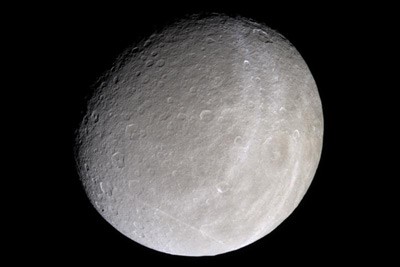No rings around Saturn's Rhea, astronomers find
By Lauren Gold
Something unknown is causing a strange, symmetrical structure in the charged-particle environment around Rhea, Saturn's second-largest moon. But contrary to 2008 reports, it's not a system of rings.
Using NASA's orbiting Cassini spacecraft, a team of astronomers led by Cornell research associate Matthew Tiscareno searched for narrow rings, broad rings and any material from dust to giant boulders that might be orbiting the 1,500 km- (950 mile)-wide moon.
They report their non-detection in the July 29 issue of Geophysical Research Letters.
The research contradicts earlier suggestions that Rhea has a system of narrow rings embedded in a broad circumsatellite disk or cloud. That 2008 announcement was based on a sharp, symmetrical drop in electrons detected around the moon by Cassini during a 2005 flyby.
If the hypothesis had been true, it would have been the first report of rings orbiting a moon. "It would be surprising," Tiscareno said.
Putting the hypothesis to the test, they positioned Cassini to view the moon at what would be edge-on to the rings, where the greatest amount of material would be within its line of sight. The researchers took 65 images between 2008 and 2009, some at high phase angles (toward the unlit side of the moon) to detect micron-sized particles that diffract light forward; and others at low phase angles (toward the lit side of the moon) to see larger objects that absorb and reflect light back toward the sun.
Looking for larger objects was more difficult, because the light reflected back from such objects would be faint compared to the light reflected back from nearby Rhea. The researchers used a series of short exposures added together to bring out any potential faint objects – but still found none.
Using the charged-particle data from the 2008 report, they also refined previous calculations of the size and abundance of ring particles that would be necessary to explain the odd observations. "We were able to say [that for] the amount of dust that you need to account for [the earlier] observations, if it were there, we would have seen it," Tiscareno said.
By disproving the ring hypothesis, Tiscareno added, the findings reopen the mystery about the cause of the 2008 observations.
"There are very strong and interesting and unexplained electromagnetic effects going on around Rhea," he said. "But we're making a pretty strong case that it's not because of solid material orbiting the moon."
The Cassini mission is a cooperative project of NASA, the European Space Agency and the Italian Space Agency. The Jet Propulsion Laboratory, a division of the California Institute of Technology, manages the mission for NASA's Science Mission Directorate.
Get Cornell news delivered right to your inbox.
Subscribe